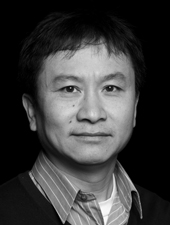Zheng, H. W., Ying, H. Q., Yan, H. Y., Kimmelman, A. C., Hiller, D. J., Chen, A. J., Perry, S. R., Tonon, G., Chu, G. C., Ding, Z. H., Stommel, J. M., Dunn, K. L., Wiedemeyer, R., You, M. J. J., Brennan, C., Wang, Y. A., Ligon, K. L., Wong, W. H., Chin, L., DePinho, R. A. (October 2008) p53 and Pten control neural and glioma stem/progenitor cell renewal and differentiation. Nature, 455 (7216). 1129-U13. ISSN 0028-0836
Abstract
Glioblastoma ( GBM) is a highly lethal brain tumour presenting as one of two subtypes with distinct clinical histories and molecular profiles. The primary GBM subtype presents acutely as a high-grade disease that typically harbours mutations in EGFR, PTEN and INK4A/ARF ( also known as CDKN2A), and the secondary GBM subtype evolves from the slow progression of a low- grade disease that classically possesses PDGF and TP53 events(1-3). Here we show that concomitant central nervous system (CNS)- specific deletion of p53 and Pten in the mouse CNS generates a penetrant acute- onset high- grade malignant glioma phenotype with notable clinical, pathological and molecular resemblance to primary GBM in humans. This genetic observation prompted TP53 and PTEN mutational analysis in human primary GBM, demonstrating unexpectedly frequent inactivating mutations of TP53 as well as the expected PTEN mutations. Integrated transcriptomic profiling, in silico promoter analysis and functional studies of murine neural stem cells ( NSCs) established that dual, but not singular, inactivation of p53 and Pten promotes an undifferentiated state with high renewal potential and drives increased Myc protein levels and its associated signature. Functional studies validated increased Myc activity as a potent contributor to the impaired differentiation and enhanced renewal of NSCs doubly null for p53 and Pten (p53(-/-) Pten(-/-)) as well as tumour neurospheres (TNSs) derived from this model. Myc also serves to maintain robust tumorigenic potential of p53(-/-) Pten(-/-) TNSs. These murine modelling studies, together with confirmatory transcriptomic/ promoter studies in human primary GBM, validate a pathogenetic role of a common tumour suppressor mutation profile in human primary GBM and establish Myc as an important target for cooperative actions of p53 and Pten in the regulation of normal and malignant stem/ progenitor cell differentiation, self- renewal and tumorigenic potential.
Actions (login required)
 |
Administrator's edit/view item |


